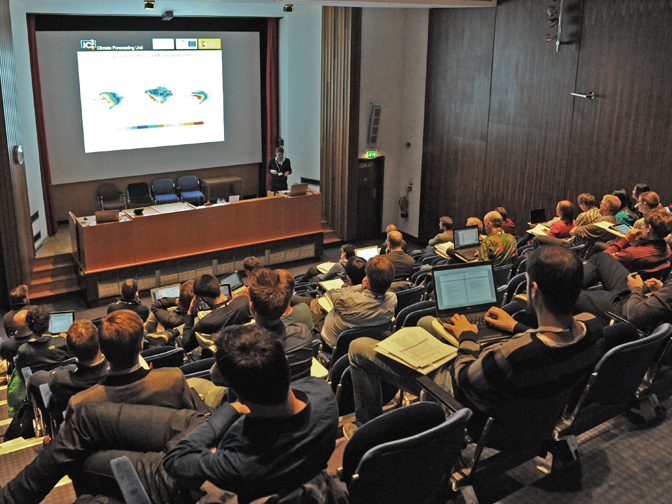

A two-day meeting of the EC-Earth consortium, hosted by ECMWF on 5 and 6 May, reviewed progress in developing an improved Earth system model for fresh insights into climate change.
EC-Earth brings together 29 European research institutes, which are collaborating to develop an Earth system model that can be used to conduct climate studies and to produce climate predictions and projections.
The meeting, which was attended by 63 participants from 10 European countries, also made plans to deepen collaboration between EC-Earth and ECMWF, which have had strong links ever since the consortium was formed nearly 10 years ago.
Ralf Döscher, the chair of the EC-Earth Steering Group, said the presentations had highlighted improvements in the consortium’s model as EC-Earth prepares to contribute to climate simulations that will feed into the next report of the Intergovernmental Panel on Climate Change (IPCC).
A new beta version of the model, including improved atmosphere, ocean, sea ice and land surface components, is due to be released within weeks, Dr Döscher said. It will be complemented by ocean biogeochemistry, atmospheric composition and dynamic land vegetation components as well as an ice sheet model for Greenland.
Collaboration “essential”
Dr Döscher, the Science Coordinator at the Swedish Meteorological and Hydrological Institute’s climate modelling research unit, emphasized the importance of cooperation with ECMWF. “The relationship with ECMWF is essential,” he said. “The basic idea of EC-Earth was to use the world-leading weather forecasting model as a climate model. From that starting point, EC-Earth has developed towards an Earth system model.”
It is planned to strengthen the collaboration in three main areas: model physics; the coupling of the ocean and the atmosphere; and atmospheric composition.
ECMWF Research Director Erland Källén said he was impressed by “the breadth of problems that are now being tackled by EC-Earth. The fact that there have been more than 60 people at this workshop shows that this initiative has spread in Europe and has become a very important contribution from Europe to the worldwide set of climate models.”
Noting the importance of international cooperation in weather forecasting, he welcomed the plans to deepen ties between the EC-Earth consortium and ECMWF. “What I’ve seen during this meeting points to the scope for further expansion of this collaboration,” he said.
The next EC-Earth meeting is scheduled to take place in Italy in January 2016. For more information on EC-Earth, visit the EC-Earth website.
